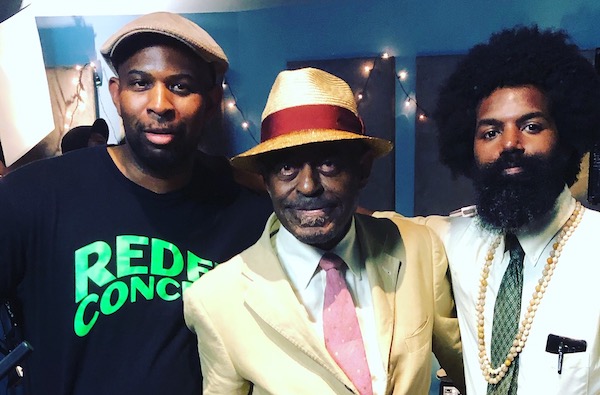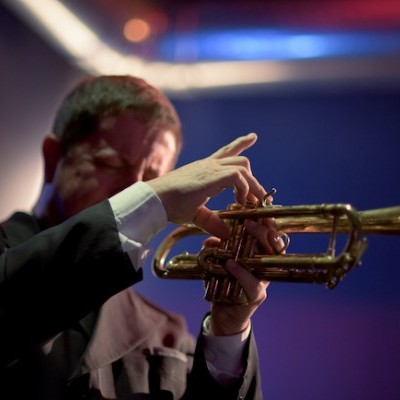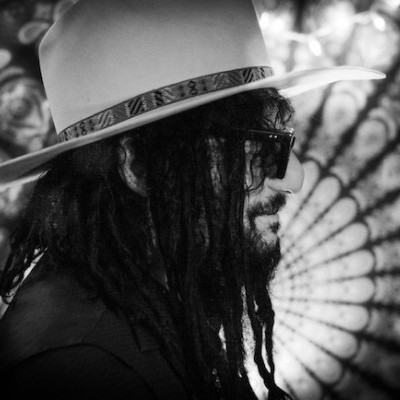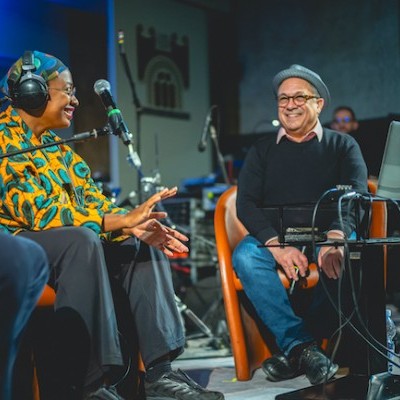Jul 9, 2024 11:35 AM
Trumpeter, Educator Jim Rotondi Dies at 61
Jim Rotondi, a renowned hard-bop trumpeter, composer and educator, died suddenly on July 7 at a hospital in France. He…

Raw Poetic (left), Archie Shepp and Damu The Fudgemunk collaborated on the album Ocean Bridges.
(Photo: Courtesy Redefinition Records)Even when family members share a musical calling, it might take decades for them to collaborate. That was the case for saxophonist Archie Shepp and his nephew Jason Moore, who performs as Raw Poetic. Their jazz-meets-hip-hop release Ocean Bridges (Redefinition) was 20 years in the making, created with input from Moore’s partner, drummer and producer Earl “Damu The Fudgemunk” Davis.
When Moore, a Washington, D.C.-based rapper, launched his career in 2000, he convinced Shepp to play on a track, “Back Into The World Again,” though it never was released. It took two decades to get Shepp back in the studio.
“He made me work for it,” Moore said. “I would send him musical ideas, and he would just say, ‘Oh, you’re not ready yet.’ It really didn’t bother me. I looked at it as if I was just taking notes from one of the greats.”
Shepp, though, hinted that he sees himself as something of a hip-hop forebearer. “I was working with words and poetry all the way back in the 1960s,” he said, citing the landmark LPs Three For A Quarter, One For A Dime (1966) and Attica Blues (1972), as well as his collaborations with Amiri Baraka, James Baldwin and Public Enemy.
“Words have a direct way of communication; music is more nuanced,” Shepp said. “You can interpret [an instrumental] any way that you want. With words added, it makes the songs’ meanings more concrete and specific.”
In 2016, when the NEA paid tribute to Shepp and other recipients of the Jazz Masters fellowship at the Kennedy Center in Washington, Moore and his mother attended the event. Several months later, Moore again approached Shepp about the prospect of collaborating. After hearing some of his then-recent work, Shepp finally agreed. And in 2019, Moore and Davis corralled a crew of five additional musicians for the sessions.
By then, the MC had gained new insight into collaborating with jazz-inclined musicians. “It’s one thing to rap over beats and it’s another thing to blend it with a certain type of melody that a jazz artist would play,” he said. “It’s about learning to breathe and using my voice like a saxophone. It felt like I was trading solos with Archie.”
Among Ocean Bridges’ highlights is “Learning To Breathe,” a percolating joint where Moore combines battle-rhymes with themes about living while Black in America.
For the sessions, Davis said that the band would warm up and start grooving while the tape rolled. Shepp would be in another room, and once the music had locked into a vamp, he’d enter the studio and find his way into the music.
Lyrics came after Moore listened to the recorded sessions: “I took it home and started breaking things apart. I had to think about where I fit inside the music. The instruments sort of told the story before my voice did.”
In between fleshed-out tracks, such as the searing “Searching Souls,” are seven interstitial pieces, each titled “Professor Shepp’s Agenda,” on which the saxophonist waxes about topics like the loss of oral histories in the Black diaspora and the value of education.
“The musicians sounded like they were trying to break some new ground, especially with the rapping,” Shepp said. “I was impressed by their enthusiasm and the novelty of their invention, particularly the spoken word. Poetry today is frequently bound up with the music. So, the message is not always so clear.”
Moore saw the project as an endeavor that ultimately boosted his skills. “The things I’ve learned the most from working with Archie is that you never stop learning, and that you should never stop experimenting. I discovered new sounds just exploring my vocal range because the music called for it. I’ve learned how to dig deeper.” DB
This story originally was published in the August 2020 issue of DownBeat. Subscribe here.

Jim Rotondi was acclaimed for his wide, round trumpet tone, remarkable virtuosity and assured swing.
Jul 9, 2024 11:35 AM
Jim Rotondi, a renowned hard-bop trumpeter, composer and educator, died suddenly on July 7 at a hospital in France. He…

Charles Lloyd, seen here at the 2024 New Orleans Jazz & Heritage Festival, makes DownBeat Poll history!
Jul 11, 2024 12:23 PM
The incomparable Charles Lloyd swept the 72nd Annual DownBeat Critics Poll, becoming the first artist ever to earn…

“Being president of Blue Note has been one of the coolest things that ever happened to me,” Was said. “It’s a gas to serve as one of the caretakers of that legacy.”
Jun 4, 2024 12:21 PM
Sitting with Don Was is a comfortable and unhurried exercise. He may seem slightly reserved at first, but ideas and…

“She reminds me of my childhood and makes we want to cry,” Cécile McLorin Salvant, pictured here with writer Ashley Kahn, said of Dianne Reeves.
Jun 11, 2024 12:31 PM
Italy’s Umbria Jazz Winter is one of those rare annual festivals that not only coincides with a major holiday —…

Maria Schneider said of Decades, her new compilation release: “I just wanted to create something, put it in a beautiful box and say, ‘Look at what we did.‘”
Jun 18, 2024 12:00 PM
Maria Schneider opened the sleek black box and placed it on a coffee table in her Manhattan apartment. Inside lay the…